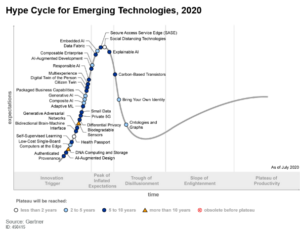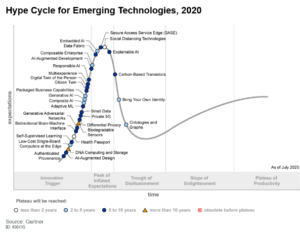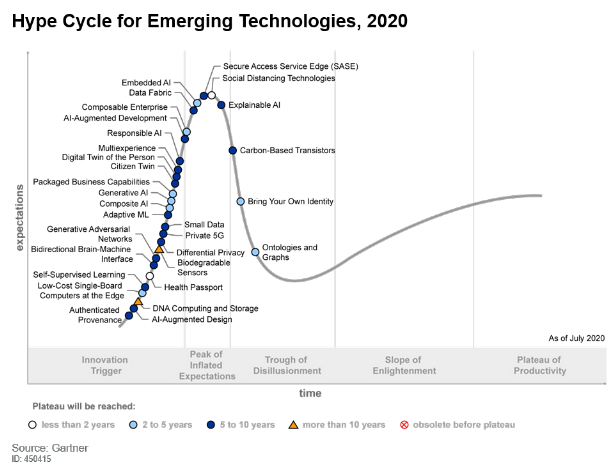Social Distancing Technologies, Composable Enterprise, AI-Assisted Design, Differential Privacy and Biodegradable Sensors Among Key Technologies to Watch
Bangkok, 26 August 2020 — The 30 must-watch technologies on the Gartner Inc. Hype Cycle for Emerging Technologies, 2020 include technologies that enable a composable enterprise, aspire to regain society’s trust in technology, and alter the state of your brain.
“Emerging technologies are disruptive by nature, but the competitive advantage they provide is not yet well known or proven in the market. Most will take more than five years, and some more than 10 years, to reach the Plateau of Productivity. But some technologies on the Hype Cycle will mature in the near term and technology innovation leaders must understand the opportunities for these technologies, particularly those with transformational or high impact,” said Brian Burke, research vice president at Gartner.
For example, health passports and social distancing technologies, both related to the COVID-19 pandemic, are taking the fast track through the Hype Cycle and have high impact. Technologies rarely enter the Hype Cycle at the point where social distancing technologies has entered it, but this technology has received extraordinary attention in the media, mainly because of privacy concerns. Health passports are also unusual as technologies with market penetration of 5-20% are rarely introduced, but this technology, required for access to public spaces and transportation in China (Health Code) and India (Aarogya Setu), is being used by hundreds of millions of people in those countries. Both technologies are expected to reach the plateau of productivity in less than two years.”
The Hype Cycle for Emerging Technologies is unique among most Gartner Hype Cycles because it garners insights from more than 1,700 technologies into a succinct set of 30 emerging technologies and trends. This Hype Cycle specifically focuses on the set of technologies that show promise in delivering a high degree of competitive advantage over the next five to 10 years (see Figure 1).
Figure 1. Hype Cycle for Emerging Technologies, 2020

Source: Gartner (August 2020)
Five Emerging Technology Trends
Digital me — Technology is becoming increasingly integrated with people to create new opportunities for digital representations of ourselves, such as digital passports and social distancing technologies. Digital twins of humans provide models of individuals that can represent people in both the physical and digital space. The way people interact with the digital world is also moving beyond screens and keyboards to use a combination of interaction modalities (e.g. voice, vision, gesture), and even directly altering our brains.
The technologies to watch include social distancing technologies, health passports, digital twin of the person, citizen twin, multiexperience and 2-Way BMI (brain machine interface).
Composite architectures — The composable enterprise is designed to respond to rapidly changing business needs with packaged business capabilities built upon a flexible data fabric. A composite architecture is implemented with solutions composed of packaged business capabilities. Built-in intelligence is decentralized and extends outward to edge devices and the end user.
To become a more agile organization, the following technologies should be tracked: composable enterprise, packaged business capabilities, data fabric, private 5G, embedded artificial intelligence (AI) and low-cost single-board computers at the edge.
Formative AI — This is a set of emerging AI and related technologies that can dynamically change to respond to situational variances. Some of these technologies are used by application developers and UX designers to create new solutions by using AI enabled tools. Other technologies enable the development of AI models that can evolve dynamically to adapt over time. The most advanced can generate entirely novel models that are targeted to solve specific problems.
Enterprises looking to explore the boundaries of AI should consider AI-assisted design, AI augmented development, ontologies and graphs, small data, composite AI, adaptive ML, self-supervised learning, generative AI and generative adversarial networks.
Algorithmic trust. Trust models based on responsible authorities are being replaced by algorithmic trust models to ensure privacy and security of data, source of assets and identity of individuals and things. Algorithmic trust helps to ensure that organizations will not be exposed to the risk and costs of losing the trust of their customers, employees and partners.
Emerging technologies tied to algorithmic trust include secure access service edge (SASE), differential privacy, authenticated provenance, bring your own identity, responsible AI and explainable AI.
Beyond silicon. For more than four decades, Moore’s Law (the number of transistors in a dense integrated circuit (IC) doubles about every two years) has guided the IT industry. As technology approaches the physical limits of silicon, new advanced materials are creating breakthrough opportunities to make technologies faster and smaller.
Critical technologies to be considered include DNA computing, biodegradable sensors and carbon-based transistors.
More detailed analysis on the Gartner Hype Cycle for Emerging Technologies, 2020 is available in the Gartner webinar “The 5 Major Trends of Gartner’s 2020 Emerging Technologies Hype Cycle.”
The Gartner Hype Cycle for Emerging Technologies 2020 introduces more than 20 technologies that are new to Gartner’s Hype Cycles, making it the go-to source to understand the newest technology and trends. Gartner clients can read more in the report “Hype Cycle for Emerging Technologies, 2020.”
Additional analysis on emerging technologies and how to reimagine your approach to technology and business strategy will be presented during Gartner IT Symposium/Xpo 2020, the world’s most important conferences for CIOs and other IT executives. Follow news and updates from the conferences on Twitter using#GartnerSYM.
Upcoming dates and locations for Gartner IT Symposium/Xpo include:
October 19-22| Americas| Virtual
October 27-29| APAC| Virtual
November 9-12| EMEA| Virtual
November 17-19| Japan| Virtual
November 23-25| India| Virtual
About Gartner
Gartner, Inc. (NYSE: IT) is the world’s leading research and advisory company and a member of the S&P 500. We equip business leaders with indispensable insights, advice and tools to achieve their mission-critical priorities today and build the successful organizations of tomorrow.
Our unmatched combination of expert-led, practitioner-sourced and data-driven research steers clients toward the right decisions on the issues that matter most. We are a trusted advisor and an objective resource for more than 14,000 enterprises in more than 100 countries — across all major functions, in every industry and enterprise size.
To learn more about how we help decision makers fuel the future of business, visit gartner.com.
นวัตกรรมทางเทคโนโลยีมาแรงที่ต้องจับตามอง ได้แก่ เทคโนโลยีที่ช่วยเรื่องการเว้นระยะห่างทางสังคม, เทคโนโลยีที่รวบรวม API เพื่อสร้างฟังก์ชั่นในรูปแบบโมดูล (Composable Enterprise), การออกแบบที่ใช้ AI เป็นตัวช่วย, การรักษาความเป็นส่วนตัวต่อข้อมูลหนึ่ง ๆ ก่อนนำข้อมูลนั้นมาใช้ และเซ็นเซอร์ที่ย่อยสลายได้
ประเทศไทย 26 สิงหาคม 2563 – รายงาน Hype Cycle for Emerging Technologies, 2020ของการ์ทเนอร์ระบุถึง 30 เทคโนโลยีที่ต้องจับตามอง ประกอบด้วยเทคโนโลยีที่ออกแบบมาเพื่อรวบรวมอินเทอร์เฟซการเขียนโปรแกรมแอปพลิเคชั่นทางธุรกิจและสร้างฟังก์ชั่นในรูปแบบโมดูลให้แก่ธุรกิจ (Composable Enterprise: CE), เทคโนโลยีที่มุ่งดึงความเชื่อมั่นในการใช้เทคโนโลยีกลับคืนมา และเทคโนโลยีที่ปรับเปลี่ยนสภาวะการทำงานของสมองของผู้คน
นายไบรอัน เบิร์ก รองประธานฝ่ายวิจัย การ์ทเนอร์ กล่าวว่า “เทคโนโลยีเกิดใหม่ทั้งหลายย่อมเป็นสิ่งที่เข้ามาดิสรัปตลาดเป็นเรื่องธรรมดา แต่ตลาดจะยังไม่เห็นตัวอย่างและยังไม่ได้รับรู้ถึงประโยชน์ด้านความได้เปรียบในการแข่งขันที่เทคโนโลยีเหล่านี้มีให้ ซึ่งส่วนใหญ่จะใช้เวลามากกว่าห้าปีหรือบางกรณีมากกว่า 10 ปีเลยทีเดียวกว่าที่จะมีการยอมรับและนำไปใช้ในวงกว้างเพื่อให้ได้ประโยชน์อย่างเต็มที่ แต่เทคโนโลยีบางประเภทที่อยู่ในวงจรการพัฒนาเทคโนโลยีของการ์ทเนอร์ (Hype Cycle) จะสมบูรณ์แบบในอีกไม่นาน ซึ่งเป็นเรื่องที่ผู้นำด้านนวัตกรรมทางเทคโนโลยีทุกคนต้องรู้ว่าเทคโนโลยีเหล่านี้จะสร้างโอกาสอะไรให้บ้าง โดยเฉพาะเทคโนโลยีที่จะส่งผลต่อการเปลี่ยนแปลงหรือจะมีผลกระทบสูง”
ตัวอย่างเช่น เทคโนโลยีที่เป็นเหมือนสมุดที่เก็บรวบรวมข้อมูลสำคัญด้านสุขภาพ (Health Passport) และเทคโนโลยีที่ช่วยด้านการเว้นระยะห่างทางสังคม ซึ่งเกี่ยวข้องกับการแพร่ระบาดของโควิด-19เทคโนโลยีทั้งสองประเภทนี้มีการพัฒนาอย่างก้าวกระโดดใน Hype Cycle และมีผลกระทบสูง ทั้งนี้มีเทคโนโลยีน้อยประเภทนักที่จะพัฒนาได้อย่างรวดเร็วถึงจุดที่เทคโนโลยีที่ช่วยด้านการเว้นระยะห่างทางสังคมทำได้ใน Hype Cycle อย่างไรก็ตามเทคโนโลยีนี้เป็นที่สนใจของสื่อมวลชนเป็นพิเศษ เนื่องจากความกังวลเรื่องความเป็นส่วนตัว ด้าน Health Passport นั้นก็ยังเป็นเรื่องฉีกแนวที่ไม่คุ้นเคย เพราะเป็นเทคโนโลยีที่ไม่ค่อยมีการนำเสนอสู่ตลาดมากนักโดยมีการเจาะตลาดเพียง 5-20% แต่เทคโนโลยีนี้กำลังได้รับการใช้งานจากประชาชนหลายร้อยล้านคนในประเทศจีนและอินเดียเพื่อใช้ในการเข้าไปยังพื้นที่สาธารณะและระบบการขนส่ง (แอปพลิเคชั่น Health Code ของจีน และ Aarogya Setu ของอินเดีย) อย่างไรก็ตามมีการคาดการณ์ว่าเทคโนโลยีทั้งสองประเภทนี้จะเป็นที่ยอมรับและนำไปใช้ในวงกว้างเพื่อใช้ประโยชน์อย่างเต็มที่ในเวลาไม่ถึงสองปี
The Hype Cycle for Emerging Technologies เป็นรายงานที่มีเอกลักษณ์แตกต่างจากรายงานด้าน Hype Cycles ด้านอื่นเกือบทั้งหมดของการ์ทเนอร์ เพราะเป็นการรวบรวมข้อมูลเชิงลึกของเทคโนโลยีมากกว่า 1,700 รายการ นำมาคัดให้เหลือเป็นชุดข้อมูลเทคโนโลยีเกิดใหม่และเทรนด์ที่กระชับ รายงานชิ้นนี้เน้นเจาะจงไปที่กลุ่มเทคโนโลยีที่แสดงให้เห็นว่าจะสามารถสร้างความได้เปรียบทางการแข่งขันในระดับสูงได้ในอีกห้าถึง 10 ปีข้างหน้า (ดูรูปที่ 1)
รูปที่ 1. วงจรเทคโนโลยีเกิดใหม่ 2563

ที่มา: การ์ทเนอร์ (สิงหาคม 2563)
5 เทรนด์เทคโนโลยีเกิดใหม่
ดิจิทัล มี (Digital me) – เทคโนโลยีกำลังหลอมรวมเข้ากับชีวิตผู้คนมากขึ้นอย่างต่อเนื่อง เพื่อสร้างโอกาสใหม่ ๆ ในการเป็นตัวแทนของผู้คนเหล่านั้นบนโลกดิจิทัล เช่น หนังสือเดินทางดิจิทัลและเทคโนโลยีการเว้นระยะห่างทางสังคม แบบจำลองผู้คนและวัตถุในโลกดิจิทัลหรือแฝดดิจิทัล (Digital Twins) ของมนุษย์ทำให้เกิดโมเดลและเอกลักษณ์ของแต่ละบุคคลที่สามารถใช้เป็นตัวแทนของเขาเหล่านั้นทั้งในโลกทางกายภาพและดิจิทัล วิธีปฏิสัมพันธ์ของผู้คนกับโลกดิจิทัลนั้นก้าวไปไกลกว่าแค่หน้าจอและคีย์บอร์ด แต่ยังหมายรวมถึงการใช้รูปแบบการโต้ตอบอื่น ๆ ร่วมกัน (เช่น เสียงพูด การมองเห็น การแสดงท่าทาง) หรือแม้แต่การเป็นสมองเพื่อคิดแทนเราได้โดยตรง
เทคโนโลยีที่น่าจับตามอง ได้แก่ เทคโนโลยีที่ช่วยในเรื่องการเว้นระยะห่างทางสังคม, Health Passport, แฝดดิจิทัลของบุคคล แฝดดิจิทัลของพลเมือง ประสบการณ์แบบหลากหลาย และการติดต่อกันโดยตรงระหว่างคลื่นสมองกับเครื่องคอมพิวเตอร์แบบ 2 ทาง (2-Way BMI: Brain Machine Interface)
สถาปัตยกรรมแบบผสมผสาน (Composite architectures) – เทคโนโลยี Composable Enterprise (CE) ได้รับการออกแบบมาเพื่อตอบสนองความต้องการทางธุรกิจที่เปลี่ยนแปลงอย่างรวดเร็ว ด้วยการรวบรวมความสามารถทางธุรกิจที่สร้างขึ้นจากโครงสร้างข้อมูลที่มีความยืดหยุ่นไว้ในที่เดียวกัน สถาปัตยกรรมแบบผสมผสานจะถูกนำไปใช้กับโซลูชันด้านการบริหารจัดการแอปพลิเคชั่นขององค์กร ระบบอัจฉริยะที่ฝังมาพร้อมจะกระจายความสามารถและขยายต่อไปสู่อุปกรณ์ปลายทางต่าง ๆ จนถึงผู้ใช้ปลายทาง
เทคโนโลยีต่อไปนี้จะช่วยให้องค์กรมีความคล่องตัวมากขึ้น: Composable Enterprise, การจัดการแอปพลิเคชั่นขององค์กร, การจัดการข้อมูลที่กระจายกันอยู่ตามจุดต่างๆ, 5G ส่วนบุคคล, การฝังเทคโนโลยีปัญญาประดิษฐ์ (AI) และคอมพิวเตอร์บอร์ดเดี่ยวราคาประหยัดที่เป็นอุปกรณ์ปลายทาง
ปัญญาประดิษฐ์ที่เป็นแบบแผน (Formative AI) – คือชุดข้อมูลของเทคโนโลยีปัญญาประดิษฐ์เกิดใหม่และเทคโนโลยีอื่น ๆ ที่สัมพันธ์กันที่สามารถปรับเปลี่ยนแบบไดนามิกเพื่อตอบสนองต่อการแปรผันของสถานการณ์ บางส่วนของเทคโนโลยีเหล่านี้ถูกนำไปใช้โดยนักพัฒนาแอปพลิเคชันและนักออกแบบด้าน UX เพื่อสร้างโซลูชันใหม่ ๆ โดยใช้เครื่องมือที่รองรับเทคโนโลยี AI เทคโนโลยีอื่น ๆ ช่วยให้สามารถพัฒนาแบบจำลอง AI แบบไดนามิกเพื่อให้สามารถปรับตัวได้ตลอดเวลา และการพัฒนาขั้นสูงสุดคือสร้างโมเดลใหม่ทั้งหมดเพื่อแก้ปัญหาเฉพาะได้
องค์กรที่กำลังสนใจนำเทคโนโลยี AI ไปปรับใช้ควรพิจารณาด้านการออกแบบโดยใช้ AI (AI-assisted design), การพัฒนาเพิ่มเติมโดยใช้ AI (AI augmented development), การแสดงความสัมพันธ์ของข้อมูลและกราฟ (ontologies and graphs), ข้อมูลขนาดเล็ก, AI แบบผสมผสาน (composite AI), แมชชีนเลิร์นนิ่งที่ปรับตัวได้ (adaptive ML), การเรียนรู้ด้วยตนเอง, generative AI และ generative adversarial networks
Algorithmic trust: โมเดลความน่าเชื่อถือต่าง ๆ ที่ทำงานตามความรับผิดชอบของหน่วยงานต่าง ๆ กำลังจะถูกแทนที่ด้วยโมเดลความน่าเชื่อถือแบบอัลกอริทึม เพื่อความมั่นใจในความเป็นส่วนตัวและความปลอดภัยของข้อมูล แหล่งที่มาของข้อมูล และการระบุตัวตนของบุคคลและองค์ประกอบอื่น ๆ โมเดลความน่าเชื่อถือแบบอัลกอริทึมนี้จะช่วยให้องค์กรมั่นใจได้ว่าจะไม่ต้องเผชิญกับความเสี่ยงและต้นทุนจากการสูญเสียความไว้วางใจจากลูกค้า พนักงานและคู่ค้าต่าง ๆ
เทคโนโลยีใหม่ที่เชื่อมโยงกับโมเดลความน่าเชื่อถือแบบอัลกอริทึม ได้แก่ Secure Access Service Edge (SASE), Differential Privacy, Authenticated Provenance, Bring your own identity, Responsible AI and Explainable AI.
ล้ำกว่าซิลิคอน กว่าสี่ทศวรรษที่กฎของมัวร์ (Moore’s Law) (อธิบายถึงจำนวนทรานซิสเตอร์ในวงจรรวมหนาแน่น (IC) จะเพิ่มขึ้นสองเท่าในทุก ๆ สองปี) คือตัวชี้นำอุตสาหกรรมไอที เมื่อเทคโนโลยีพัฒนาจนใกล้ทะลุขีดจำกัดทางกายภาพของซิลิคอน ส่วนประกอบที่ล้ำสมัยใหม่ ๆ กำลังสร้างโอกาสที่สำคัญหลายประการที่ทำให้เทคโนโลยีมีความรวดเร็วขึ้นด้วยขนาดเล็กลง
เทคโนโลยีสำคัญที่ต้องพิจารณา ได้แก่ DNA computing เซ็นเซอร์แบบย่อยสลายได้ และทรานซิสเตอร์ที่ผลิตจากคาร์บอน
ศึกษารายละเอียดการวิเคราะห์จาก The Gartner Hype Cycle for Emerging Technologies, 2020 เพิ่มเติมได้ที่เว็บบินาร์ของการ์ทเนอร์ “The 5 Major Trends of Gartner’s 2020 Emerging Technologies Hype Cycle.”
The Gartner Hype Cycle for Emerging Technologies 2020 นำเสนอเทคโนโลยีมากกว่า 20 รายการใหม่ให้กับ Hype Cycles ของการ์ทเนอร์ ทำให้ Hype Cycles เป็นแหล่งข้อมูลที่จะนำไปสู่ความเข้าใจเทคโนโลยีและเทรนด์ใหม่ล่าสุด ลูกค้าการ์ทเนอร์สามารถอ่านเพิ่มเติมได้ในรายงาน “Hype Cycle for Emerging Technologies, 2020.”
การวิเคราะห์เพิ่มเติมเกี่ยวกับเทคโนโลยีเกิดใหม่และวิธีการปรับเปลี่ยนแนวคิดในการเข้าใช้เทคโนโลยีและกลยุทธ์ทางธุรกิจจะถูกนำเสนอใน Gartner IT Symposium/Xpo 2020, ซึ่งเป็นการประชุมที่สำคัญที่สุดในโลกสำหรับซีไอโอและผู้บริหารไอทีอื่น ๆ ติดตามข่าวสารและอัปเดตการประชุมบน Twitter ได้ที่ #GartnerSYM
วันและสถานที่จัดงาน Gartner IT Symposium / Xpo :
October 19-22| Americas| Virtual
October 27-29| APAC| Virtual
November 9-12| EMEA| Virtual
November 17-19| Japan| Virtual
November 23-25| India| Virtual
เกี่ยวกับการ์ทเนอร์
บริษัท การ์ทเนอร์ (Gartner, Inc.) (NYSE: IT) คือบริษัทวิจัยและให้คำปรึกษาชั้นนำของโลก และมีรายชื่ออยู่ในดัชนี S&P 500 บริษัทฯ ให้ข้อมูลเชิงลึก คำแนะนำ และเครื่องมือต่าง ๆ แก่ผู้บริหารองค์กรธุรกิจ เพื่อรองรับการดำเนินภารกิจสำคัญที่มีอยู่ในปัจจุบันและสร้างองค์กรให้ประสบความสำเร็จในอนาคต
การ์ทเนอร์นำเสนองานวิจัยที่ขับเคลื่อนด้วยข้อมูล ดำเนินการโดยผู้เชี่ยวชาญ และใช้แหล่งข้อมูลจากผู้ปฏิบัติงานจริง เพื่อชี้นำลูกค้าสำหรับการตัดสินใจที่ถูกต้องเหมาะสมในเรื่องที่สำคัญที่สุด การ์ทเนอร์ทำหน้าที่เป็นแหล่งข้อมูลที่เป็นกลางและเป็นที่ปรึกษาที่ได้รับความไว้วางใจจากองค์กรต่าง ๆ กว่า 15,000 แห่งในกว่า 100 ประเทศทั่วโลก ครอบคลุมทุกส่วนงานสำคัญ ๆ ในทุกกลุ่มอุตสาหกรรมและองค์กรทุกขนาด
ดูข้อมูลเพิ่มเติมเกี่ยวกับแนวทางของการ์ทเนอร์ในการช่วยให้ผู้บริหารตัดสินใจอย่างถูกต้องเพื่อขับเคลื่อนอนาคตของธุรกิจได้ที่ gartner.com


